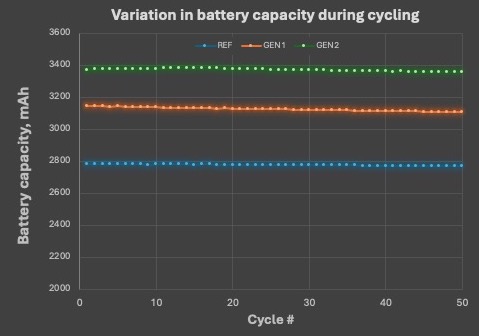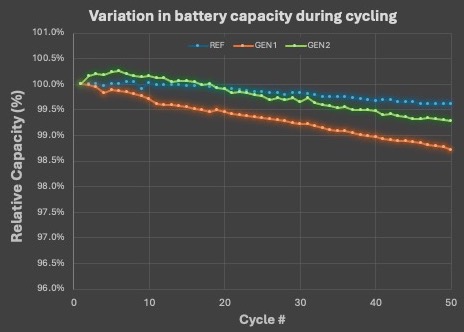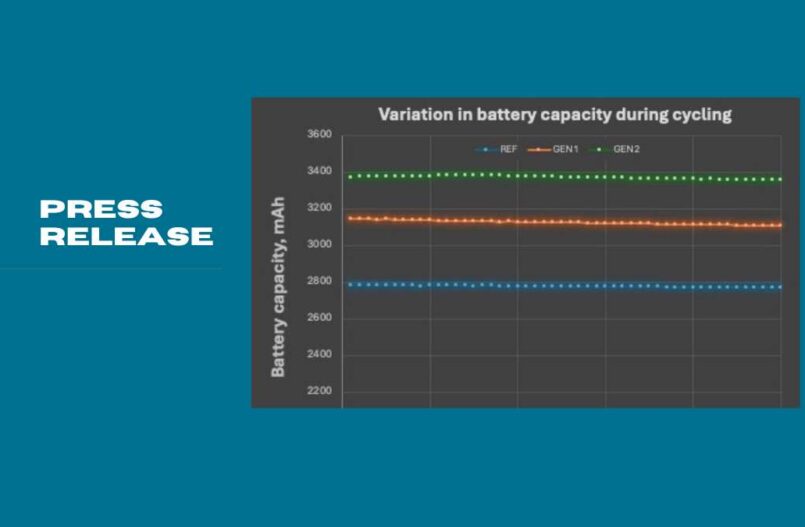- Testing results at 50 cycles of GEN2 material show an overall capacity improvement of approximately 30% compared to the graphite benchmark and 14% better compared to Gen 1 material, without any noticeable cycle degradation [1].
MONTREAL, Canada — HPQ Silicon Inc. (“HPQ” or the “Company”) (TSX-V: HPQ) (OTCQB: HPQFF) (FRA: O08), a technology company specializing in green engineering of silica and silicon-based materials is pleased to announce the latest battery milestones achieved by its France-based affiliate, NOVACIUM SAS (“Novacium”).
This announcement highlights the remarkable results obtained during the initial 50-cycle tests of 18650 industrial batteries made with Novacium’s non-optimized second-generation advanced silicon-based anode material.
“These results continue to showcase our ability to produce a blend of graphite and advanced silicon anode material that can be seamlessly integrated into existing anode manufacturing facilities, improving overall battery performance,” stated Dr. Jed Kraiem, Ph.D., COO of Novacium. “As we continue improving our material and its performance, our work will also focus on assisting HPQ in becoming a North American and European manufacturer of next-gen engineered silicon-based anode materials.”
UNLOCKING ENHANCED BATTERY PERFORMANCE WITH SILICON BASE ANODE MATERIALS

of GEN1 batteries, and the green line shows average capacity of GEN 2, all measured in milliampere-hours (mAh) [1]

capacité moyenne des batteries GEN1 et la ligne verte montre la capacité moyenne de GEN 2,
toutes mesurées en milliampères-heures (mAh) [1].
The figure above illustrates the progression in battery capacity over 50 cycles. The blue line represents the average capacity of three (3) 18650 batteries with 100% graphite at around 2,775 mAh. The orange line shows the average capacity of three (3) 18650 batteries using Novacium GEN1 materials at around 3,174 mAh. Finally, the green line depicts the average capacity of three (3) 18650 batteries using Novacium GEN2 materials at around 3,379 mAh.
These results indicate that during the first 50-cycle test, the batteries made with Novacium non-optimized GEN2 materials continue to show approximately a 30% improvement compared to the graphite benchmark and about a 14% improvement compared to the batteries made with Novacium GEN1 materials.
DELIVERING MINIMAL BATTERY DEGRADATION AT 50 CYCLES

of GEN1 batteries, and the green line shows relative capacity of GEN 2, over 50 cycles [1].

Results from Figure 2 continue to demonstrate a minimal increase (about 1%) in measurable cycle degradation during the first 50 cycles. The blue line represents the average relative capacity of three (3) 18650 batteries with 100% graphite; the orange line shows the average relative capacity of three (3) 18650 batteries made using Novacium GEN1 materials, and the green line depicts the average relative capacity of three (3) 18650 batteries using Novacium GEN2 materials.
“Novacium’s non-optimized second-generation engineered silicon anode material continues to deliver results that surpass those obtained with Novacium GEN1 materials. These promising results have real-world applications,” stated Mr. Bernard Tourillon, President and CEO of HPQ Silicon Inc. and NOVACIUM SAS. “These achievements open new doors for HPQ as we strive to become a manufacturer of next-gen engineered silicon-based anode materials in jurisdictions that support these types of initiatives.”
REFERENCE SOURCES
[1] Novacium technical team analysis of the data from the ongoing charging and discharging cycle tests conducted at a world-leading university, the name of which is kept confidential for competitive reasons.

